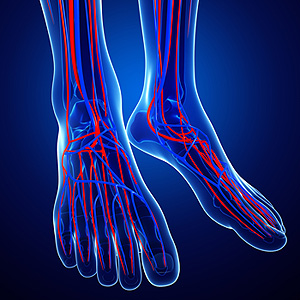 Poor circulation will often be obvious in the feet. Many patients will generally notice numbness and swelling in the toes and feet in addition to discomfort and pain while walking or standing. Diabetics may notice a slower healing process for any sores that appear on the feet and the skin may begin to change color. There are several factors that may cause this ailment including high blood pressure and hardening of the arteries, which is a buildup of excess plaque in the blood. Research has shown that massaging the feet will gently circulate the blood and may bring moderate relief. Additionally, incorporating a mild exercise program into your daily routine may be difficult, but it may prove to be beneficial in attaining improved circulation and the overall health of the body. A consultation with a podiatrist is suggested for information on how to manage poor circulation in the feet.
Poor circulation will often be obvious in the feet. Many patients will generally notice numbness and swelling in the toes and feet in addition to discomfort and pain while walking or standing. Diabetics may notice a slower healing process for any sores that appear on the feet and the skin may begin to change color. There are several factors that may cause this ailment including high blood pressure and hardening of the arteries, which is a buildup of excess plaque in the blood. Research has shown that massaging the feet will gently circulate the blood and may bring moderate relief. Additionally, incorporating a mild exercise program into your daily routine may be difficult, but it may prove to be beneficial in attaining improved circulation and the overall health of the body. A consultation with a podiatrist is suggested for information on how to manage poor circulation in the feet.
While poor circulation itself isn’t a condition; it is a symptom of another underlying health condition you may have. If you have any concerns with poor circulation in your feet contact Dr. Odin De Los Reyes of Connecticut. Our doctor will treat your foot and ankle needs.
Poor Circulation in the Feet
Peripheral artery disease (PAD) can potentially lead to poor circulation in the lower extremities. PAD is a condition that causes the blood vessels and arteries to narrow. In a linked condition called atherosclerosis, the arteries stiffen up due to a buildup of plaque in the arteries and blood vessels. These two conditions can cause a decrease in the amount of blood that flows to your extremities, therefore resulting in pain.
Symptoms
Some of the most common symptoms of poor circulation are:
- Numbness
- Tingling
- Throbbing or stinging pain in limbs
- Pain
- Muscle Cramps
Treatment for poor circulation often depends on the underlying condition that causes it. Methods for treatment may include insulin for diabetes, special exercise programs, surgery for varicose veins, or compression socks for swollen legs.
As always, see a podiatrist as he or she will assist in finding a regimen that suits you. A podiatrist can also prescribe you any needed medication.
If you have any questions, please feel free to contact our offices located in Southbury and Farmington, CT . We offer the newest diagnostic and treatment technologies for all your foot care needs.
